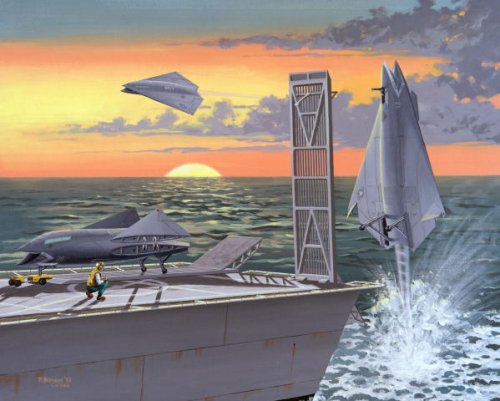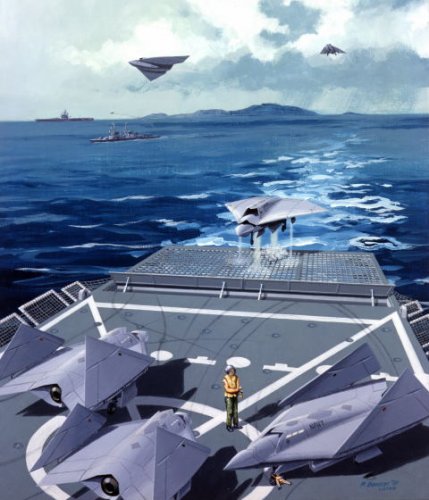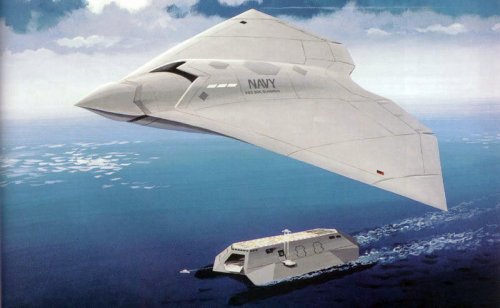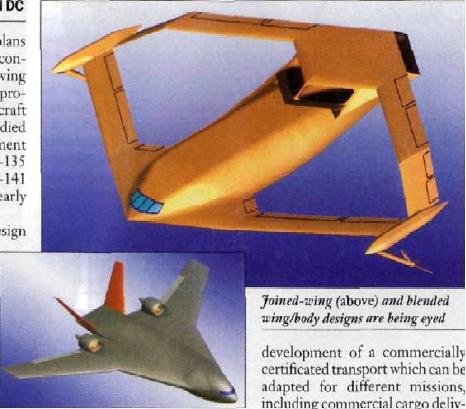At the risk of going over old ground, I will dispense first with the "existing aircraft" procurement programmes now under way:
CSAR-X (HH-47 selected, but under protest)
JCA (C-27J vs C-295, to be decided in May)
KC-X (KC-767 vs KC-30, to be decided by October)
CVLSP (USAF UH-1 replacement)
BAMS (US Navy high-altitude, long-endurance UAV)
Now the "future" programmes:
N-UCAS - US Navy unmanned combat air system: low-observable carrier-based UCAV: UCAS-D demonstrator programme to begin this year; Boeing X-45N competing against Northrop Grumman X-47B
LRS - US Air Force long-range strike: ultra-low-observable next-generation bomber to enter service by 2018; Boeing, Lockheed Martin and Northrop Grumman have studied the four combinations of subsonic and supersonic, manned and unmanned; current thinking is the USAF will pick subsonic, initially a manned A-model followed by an unmanned B-model; programme to begin this year
AJACS - US Air Force next-generation STOL or ESTOL (extreme STOL) tactical transport to replace C-130 after 2020; formerly called AMC-X, this is not yet a "programme of record"; AFRL plans to award up to three contracts this year to design an advanced composite cargo aircraft flight demonstrator, with the winning "X-plane" to fly within 17 months of contract award
JHL - US Army-led programme for a heavy-lift rotorcraft able to carry Future Combat Systems vehicles around the battlefield; this is not yet a programme of record, and might yet be merged with AJACS; four concept design and analysis contracts, now completed, covered designs in two speed ranges - the Boeing Advanced Tandem Rotor Helicopter and coaxial-rotor Sikorsky X2 Technology Crane at the lower speed; the Bell Boeing Quad Tilt Rotor and Sikorsky X2 Technology High Speed Lifter at the higher speed; and Frontier Aircraft's Optimum Speed Tilt Rotor. Karem designed the precursor to the Predator UAV and the Frontier Systems (now Boeing) A-160 Hummingbird long-endurance unmanned helicopter, which has an optimum-speed (variable RPM) rotor. There is a patent for the OSTR rotor, but I have not found anything on the overall vehicle design for JHL.
JMR - US Army and Marine Corps joint multi-role rotorcraft to replace both the Boeing AH-64D Apache and Bell AH-1Z SuperCobra at some undefined - and unfunded - point in the future. Potential contenders could include an attack derivative of the Bell-Agusta BA609 tiltrotor. The Boeing Canard Rotor Wing was a contender until the X-50A demonstrator crashed a second time
There are others out there, including a next-generation gunship (AC-130 replacement), and a long-range reconnaissance platform (possibly unmanned). But funding for them is small to non-existent - or classified.
There are also a number of flight demonstrators in the pipeline, but far from certain to fly. These include:
Heliplane - a DARPA programme to demonstrate a high-speed VTOL gyroplane, with Groen Brothers
Falcon - a DARPA programme with Lockheed Martin's Skunk Works to demonstrate technology for a "prompt global strike" hypersonic cruise vehicle (HCV); the planned hypersonic test vehicles will initially be rocket-launched, unpowered and expendable, but ultimately will be reusable, with turbine/scramjet combined-cyle propulsion enabling a runway take-off and landing
Waverider - this covers the rocket-boosted, scamjet-powered X-51A, with a Pratt & Whitney Rocketdyne engine and the X-51C with an alternative Alliant Techsystems scramjet. There is also an unfunded X-51B with a turbine/rocket combined-cycle engine. X-51 is aimed at demonstrating aero-propulsion technology for a hypersonic missile and/or an air-breathing reusable launch vehicle
SMV - an AFRL programme to demonstrate an orbital space manoeuvre vehicle; this is basically the ex-NASA, ex-DARPA X-37; planned to be carried into orbit in the Space Shuttle payload bay, the X-37A was cut back to an atmospheric drop test vehicle and ran off the runway after landing successfully from its first and only drop; the X-37B SMV is planned to be launched into orbit on an expendable booster
There are a few others...




